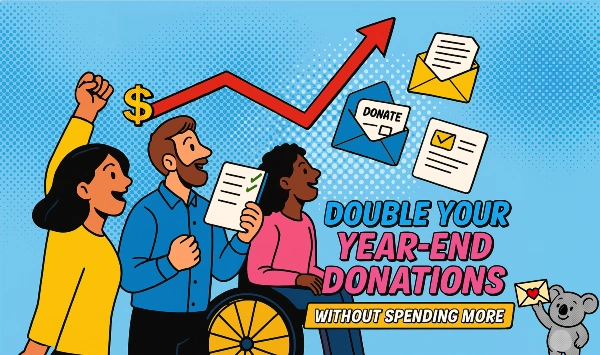This happened to me. Tell me if you’ve had a similar experience:
I wrote a year-end appeal for a social services agency that focused on addiction recovery. I had an incredible story to work with: it was about one of their clients who lived through a harrowing addiction, a life of violent crime, and an amazing recovery. It was one of the most powerful stories I’ve ever written. And I’ve written a lot of stories.
Long story short, the appeal goes through the usual approvals process. Everyone is happy with the story – it’s accurate, clear, and illustrates what donors’ giving will help make possible.
Then, at the very last stage, the appeal now fully designed and ready to go to the printer, it’s sent to a program manager. Someone who works with the clients and knows what’s going on.
“We can’t tell that story,” they say. “That client has relapsed. He’s now in prison!”
We now had hours to revise the appeal. It was the year-end appeal, so the deadline really wasn’t moveable.
We found a new story – bland and pale by comparison, but it was all we could come up with. The designer and I stayed up late to make it happen.
It did okay. But not great, like it might have with the original story in it.
That kind of thing happens. Sometimes it’s unavoidable. But more often, it’s easily avoidable, and I’m going to show you some ways to avoid trouble.
Not just trouble with stories, but all kinds of trouble that make fundraising more difficult and frustrating than it should be.
The philosophy of this approach is to minimize the number of steps where everyone has a say and maximize the expertise of everyone – at the right time.
Step #1: Write the brief
Who is involved: Fundraising lead, maybe the copywriter, possibly others for expert help.
Here’s what the brief should put in writing:
- Purpose, audience, goals, context: Many projects go sideways because there were different assumptions and they were never put in writing. This is the place to make it clear what you’re doing and why, as well as any knowledge from the past that might inform you.
- Offer: The specific action we want donors to make possible. This is the single most important piece of information on the brief. Agreeing on the what the donors’ gifts will do and how you’ll talk about it is a must. This should include your plan for asking each donor for the right amount. Write it exactly the way it will appear on the reply device and/or donation page.
- Copy points: Things we want to make sure are covered in the message.
- Story: No need to write it — just make it clear what the story (or stories) you plan to tell and what is its source.
That’s the basics. You can add more as needed.
The purpose of the brief is to uncover any problems early. For any matters of opinion to be surfaced before the work starts in earnest. And for conflicts to be discussed and resolved.
A brief can be an almost magical document that improves the quality of your work, decreases the time it takes to do it, and promotes peace and love in your workplace. An hour spent at the beginning of project defining and planning and putting it in writing in a brief will save many hours later on.
Step #2: Talk about the brief
Who is involved: Everyone with a stake in the campaign. From the creative team, to the boss, to program experts. This is the one place where everyone can chime in.
This is the stage where everyone speaks. Is that a good expression of the donor call to action? Is everything accurate? Can we tell the story we’re proposing here? A solid brief should insure that nobody will be surprised by what they see when the actual campaign is seen.
Step #3: Write the copy
Who should be involved: the copywriter, an editor or creative director, a proofreader
This is the stage where you start to narrow down the range of voices that can chime in. Because effective fundraising is an often counterintuitive craft. A non-expert who “doesn’t like” something about the writing should not hold sway over what is written. That’s why the team here should be the writer and a couple of types of “quality control”: Someone with deep fundraising experience who can help with structure and other copywriting issues, and someone who can proof for spelling, grammar, and facts.
Sometimes it’s necessary to include the person who will be signing the letter. After all, it’s going out with their name on it. Ideally, that person grows comfortable with the tighter team and becomes more trusting of the final product.
Step #4: Design
Who should be involved: the copywriter, an editor or creative director, a proofreader (same group as above).
Design can elevate your message – or crush its effectiveness. We always want the words and the design pulling in the same direction, telling the same story. As with the writing, less-informed opinions of those who are not trained on fundraising should not hold sway at this stage. They had their say at Stage #2.
Step #5: Production
Who should be involved: Whoever is in charge of production, proofreader, sometimes the designer.
By this time, there shouldn’t be many revisions. That’s why so few people are active at this stage.
How it might feel
Some people won’t like this approach. It may feel like a loss of power or of voice. They need to believe in the Brief as their chance to influence the project. I’ve found that when teams adhere to that, they concentrate a lot more on the brief than they do if they think, “I can always deal with it later.”
Yes, all the voices matter. But they don’t all matter in the same way and at the same time. This approach can really improve the quality of your fundraising. And make life easier for everyone.
Looking for some quick improvements to your fundraising? Get the Moceanic FREE Guide: 5 Donor Love Tips To Boost Your Fundraising In Hard Times. These are easy, proven tactics that help you connect with donors for more revenue, better retention, and stronger relationships. Click through for your copy today!
Please share your experience by leaving your reply below. We’d love to learn from your experience.












1 Comment. Leave new
Jeff, this seems like a brilliant idea; it’s like writing an outline before you begin writing a paper or report. It organizes your thoughts and everyone else’s. Telling the large group it’s their only chance to contribute should make them focus on the message. Then it should facilitate the fundraiser’s ability to complete and send out the solicitation. If someone like the volunteer chair of the development committee decides later they don’t like it, the fundraisers says nicely, “you approved it when we had the brief.” Makes total sense to me, sounds like a great idea.